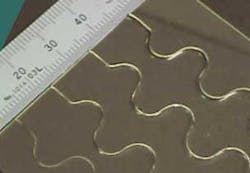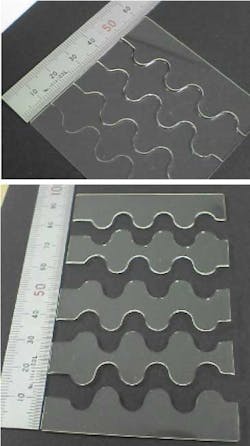Thermal stress cleavage is a new business
An explanation of the technology and market
By Norio Karube
Consider a glass falling onto a bare floor from the height of one meter. It breaks into fragments instantly. This simple occurrence indicates the three inherent principles of material processing.
The first principle is that this breakage is caused by an extremely small quantity of potential energy corresponding to a one meter height difference (approximately 1 joule for 100 g glass weight). In other words, a single alkaline dry cell (AA) can break 10,000 glasses, meaning that this is a phenomenon of surprisingly ideal energy saving, which occupies an important significance today.
The second principle is that the breakage takes place instantly. The propagation velocity of cleavage is said to be roughly half of the sound velocity in the same material, which means that this is a fairly high speed phenomenon.
The third lesson is that the broken pieces shine, meaning the cleaved surface of the pieces are flat in the dimension of at least visible light wavelength, indicating the possibility of high quality.
Thus, when a breaking glass is considered as a possible means of material processing and not a mere destruction, it can potentially produce such technical advantages as energy saving, high process velocity and high process quality, all of which can satisfy the requirements for today’s material processing.
Unfortunately, glass breakage is a method of destruction and not any kind of material processing. What then is the difference between destruction and material processing? The answer is that the latter requires controllability, which does not exist in the former. After several years of research, the author is convinced that this required controllability can be achieved in the following way.
The mechanical stress as a driving force in the above phenomenon should be replaced by the thermal stress, which can be controlled if it is generated by the laser beam irradiation as a material heating means. The reduction of the amount of required energy as well as the position control can be realized by utilizing the stress magnification at the tip of crack. Furthermore, the teaching of linear elastic fracture mechanics can shed light on this less clarified phenomenon of thermal stress cleavage.
Thus it will be possible to pave the way to develop a new material processing technology for brittle materials such as glass and to accomplish, in this technology, the advantage of energy saving, high speed, and high quality, which have so far been unachieved in tconventional material processing.
History
The thermal stress cleavage of a glass sheet has been done by glass blowers in small volume production. The author witnessed it many times in physics laboratories when glass sheets were processed for straight line as well as for curve profiles. The glass blower first presses a thin glass rod, the tip of which is molten, onto the sheet. The surface of the sheet can then be heated at the position to be processed. He then cools the spot by placing a wetted finger, where cleavage takes place. By repeating this process along the required path, the entire cleavage is achieved without using any special tools.
In 1992, Kondratenko filed the basic patent in Russia and in the next year in other countries utilizing the same principle, which was the translated version into sophisticated modern technology [1]. He proposed the use of a scanned CO2 laser beam for heating the glass surface. The absolute majority of laser beam is absorbed only in the glass surface area and, helped by the subsequent heat conduction, the cleavage takes place in the form of surface scribing within a depth of 100 micron. By applying the subsequent breaking technology, the scribed sheet is cleaved throughout the entire thickness. He also proposed the use of an elongated laser beam in the scanning direction and cooling equipment placed immediately after the end of heated area. These patents expire either in 2012 or 2013, but in most of the countries where they were filed, the range of coverage was considerably reduced through patent examinations. Some lawyers doubt the validity of these restricted patents. The advantages of this technology include the absence of micro-cracks and cullet, which can preserve the material strength endowed during glass manufacturing. His technology is currently used by some companies to process the glass sheets in sophisticated applications such as flat panel display devices.
This technology of Kondratenko was exceeded by the author, who pursued the theoretical as well as experimental investigation [2, 3]. The author developed the technology of laser beam heating not only in the surface layer but in the entire thickness of the glass, which extended the cleavage technology from surface scribing up to full body cutting. The breaking procedure is not necessary in this process. He then pursued the theoretical investigation of cleavage and showed that the finite element method used in linear elastic fracture mechanics can be used to determine the temperature distribution on the glass sheet in order to generate the thermal stress for obtaining the specified cleavage. Most of this investigation, still in the theoretical stage, was partially verified by the author’s experiments. The target of these studies will be the generalized cleavage of brittle materials, which is expected to produce abundant processing merits.
Today’s technology
The essence of this technology can easily be understood by referring to FIGURE 1, which conceptually illustrates the comparison between the two cases, i.e., the thermal stress cleavage shown on the left-hand side and the high power density laser beam processing on the right-hand side. The essence of the former is the dissociation of the chemical bond between the adjacent atomic planes producing zero kerf, which will be generated by the tensile stress exceeding the yielding stress for fracture. The latter, on the other hand, is accompanied by the formation of the kerf of 0.1 mm corresponding to the spot size of the same diameter, where all the material should be deleted by material transformation. Consider the presence of approximately 105 atomic planes in the kerf in this case. The origin of both of the energy saving and the completely flat cleaved surface in the case of thermal stress cleavage can be understood from this diagram.
The tensile stress required for this bond dissociation can be generated by non-uniform temperature distribution in the work. Usually uniform temperature distribution in glass is known to guarantee the elimination of thermal stress. The contrary case holds. In it, the tensile as well as compressive stresses are formed, both of which are perpendicular. When we expect the above mentioned dissociation to take place without the existence of any preceding crack in the area, the required stress becomes impractically great. However, according to linear elastic fracture mechanics, the required stress becomes, by far, reduced if the cleavage takes place in the form of extension from its preceding tip. This technology was investigated by Irwin for the purpose of evaluating the structural safety in the presence of defects [4] and later by his followers. Here in place of discussing the problem in terms of stress itself, we consider stress intensity factor K, which can be calculated using the finite element method. This factor indicates not only if the cleavage takes place or not, but in what way it occurs, which can be used as the basis for realizing the specified cleavage profile. This method was used by the author in the case of full body cutting.
This non-uniform temperature distribution in glass can be generated by laser beam irradiation. The typical laser used for material processing is a CO2 laser. Due to its extremely large absorption coefficient in glass, 99% of its incident energy is absorbed in the surface layer at a depth of 3.7 µm in the case of non-alkaline glass, resulting in surface heating. Because Kondratenko was interested only in the surface scribing, he selected this CO2 laser as the most appropriate one. For realizing the full body cleavage, however, the bulk heating of glass is required. The laser beam, which is partially transparent and partially absorptive, is necessary. As a usable laser does not exist that possesses this property, the author solved the problem by doping the non-alkaline glass with 5 mol % Yb together with the use of LD laser of the wavelength of 976 nm for achieving the full body cleavage. Another typical material processing laser is a YAG laser.
This laser is highly transparent in pure glass and requires multiple passages of beams in glass for realizing appropriate bulk heating [5]. The absorption characteristics of these three cases are shown in FIGURE 2. Depending on the penetration characteristics of the laser beam used, the thermal stress cleavage of glass can be divided into the two kinds, i.e. surface scribing and full body cutting.
FIGURE 3 shows the cleaved surface comparison of both the types together with the case of mechanical scribing shown on the left-hand side. As is clear from the figure, the technology used in today’s manufacturing, i.e. the mechanical scribing together with the mechanical breaking shown on the left-hand side, generates cullet and micro-crack, which requires subsequent processes such as grinding and cleansing. The biggest problem is the deteriorated material strength of glass due to the presence of micro-cracks.
In either of the cleaved surface scribing by a CO2 laser shown in the center or the full body cleavage shown on the right-hand side, neither cullet nor micro-crack exists, which justifies the availability of the technology in spite of its high cost. Both of these possess advantages and disadvantages. The usefulness and market size are much bigger in the full body cleavage. Its disadvantages include the absence of laser and what Kontradenko called the size effect. There are two meanings of size effect. The first is that the cleavage becomes more difficult in larger works. The second is that the positional accuracy of cleavage becomes inferior depending on the size and shape of work. The basic method to solve these problems was shown by the author [2, 3].
In the full body cleavage, the breaking procedure is not necessary. The cooling, which is performed just after the end of heating in the case of surface scribing, is not done either. When perfected, this technology will replace surface scribing and will increase the market size of the cleavage business considerably. FIGURE 4 shows one of the merits, i.e. profile cutting of glass using this cleavage technology. This technology becomes possible due to the absence of breaking.
FIGURE 5 shows another merit, i.e. selective cleavage of a laminated sheet. Because the laser beam can penetrate multiple sheets, the cleavage takes place only where the initial cracks are prepared and does not take place where initial cracks are not prepared. Thus the selected cleavage is formed only on the sheets and where the cleavage is required only by the laser beam irradiation in one direction and without reversing the work.
FIGURE 6 shows the principle of cleavage used in most of the equipment: full body cleavage. The bulk of work is heated by a scanned laser beam of proper absorption. The full body cleavage is formed at the position where the stress intensity factor takes the maximum value. This position usually does not coincide with the spot where the temperature becomes maximum, generating what is called size effect. In this figure, this size effect is avoided by converting the direction of work distortion accompanying full body cleavage to be perpendicular to the work surface. The case of surface scribing is much simpler but needs a cooling unit placed immediately after the end of work heating. Because the present business competition is mostly performed using the technology of surface scribing, the competition is mostly being made to improve the capability of surface scribing technology.
Tomorrow’s technology
In this section, the pragmatic aspects of thermal stress technology, especially those that are important in growing business, are described. The description covers not only active investigations but also future investigations . The present business is being performed to process the glass used in flat panel display (FPD) devices utilizing the surface scribing process followed by mechanical as well as manual breaking. The competition pursues enhancing the quality and performance of this technology. The glass used in the FPD industry is shifting to thinner thickness in one and strengthened in the other one. Enriching the recipe for dealing with various kinds of glass in composition, material preparation procedure, thickness both thick and thin, structure of the final commercial products, etc. is active. Processing recipes in different applications should be prepared in the form of application software as is done in conventional laser material processing. In spite of its active utilization in the industry, theory of surface scribing is not completed. The theoretical as well as experimental investigation of full body cleavage was performed by the author because this cleavage is basically a 2D phenomenon and is much simpler. On the other hand, surface scribing is basically a 3D phenomenon and is much more complicated to analyze. Although the business is actively pursuing this technology, all the tests need to be done empirically due to the lack of theoretical tools, which is time consuming. Our team awaits the advent of applicable theory for 3D analysis.
The reason why full body cleavage is not yet applied in business in spite of the rich advantages is the presence of size effect. The absence of a bulk heating laser is one problem, which is not fatal, however. When the glass thickness is less than 2 mm, the thermal conduction of heat enables the full body cleavage using CO2 laser. This thickness will become a common sense for glass for future mobile devices and then the problem of absence of usable laser will disappear. The size effect, however, remains to be solved.
The size effect is caused by the fact that full body cleavage is always accompanied by the entire distortion of work, which is influenced by the structural size and shape of work and the position of cleavage. The position where the thermal stress is maximum does not necessarily coincide with the position where the stress intensity factor becomes maximum and generates full body cleavage. What is important is the distribution of the stress intensity factor and not the temperature distribution. In surface scribing, the scribing phenomenon is a local one which is not influenced by the entire condition of work. Kondratenko was pessimistic about solving the problem and considered that surface scribing was the only applicable technology. The author, on the contrary, considers that the preparation of proper temperature distribution for obtaining specific distribution of stress intensity factors will solve this problem. This preparation can either empirically or theoretically be made. While the former can be done by means of negative feedback or feed-forward technology, which will be more pragmatic, the latter can be done by the application of the finite element method. The author also considered that it is possible to minimize this problem by converting the direction of work distortion for full body cleavage from parallel to the work surface to perpendicular to it. This technology will also be pragmatic. It is disappointing that these solutions are in their infancy and need to be developed more.
The other problems related to business expansion include C cut processing, cross cut one, initial crack formation using laser beam, breaking by applying thermal stress, ultrafast processing, micro processing and others. The extension to processing semiconductors and ceramics using this principle is also important to grow the business.
Growing business
In this section, the business sectors in which this technology can be utilized are considered together with an estimate of market size.
Three companies are directly engaged in the laser cleavage system business for glass sheets in the worldwide market. They manufacture and supply the cleavage equipment in the category of surface scribing for processing the glass sheets used in FPD. All of them are Japanese companies, which manufacture their products in Japan and supply the products to the glass processing companies in Japan, Korea, Taiwan and China.
MDI, Osaka, possesses the biggest share in the glass cutting technology business in the world using the conventional diamond tool technology. Its target is all kinds of glass used in various applications. MDI is also engaged in the laser glass cleavage business, which is mostly used in the field of sophisticated products. The laser machine business is only a small part compared with the conventional technology one, but will grow as the technology advances. The company's annual revenue for the past fiscal year is approximately $240 million. The total world market of glass cutting machines will be approximately double, most of which will be replaced by the laser technology business eventually.
LEMI, Osaka, is the company founded by the author and is engaged in the business of laser glass cleavage, mostly with small machines. The annual revenue of this company for the past fiscal year is $33 million.
LEO, Kanagawa, is engaged in the OEM business of laser glass cutting engines to be supplied to the machine tool builders, which are interested in this business. The author works for this company, which is just starting their products supply.
The above description is today’s market size, which can give a hint to the future of this business. Finally the coverage to all kinds of glasses in extensive markets will be done when improvements are made in performance and cost.
Following the glass business, the expansion can be expected to processing semiconductor disks and electronic ceramic components, which are different types of brittle materials. Mechanical stress cleavage is already being used in the production of LD as well as LED cells because of their high accuracy and quality. Presently, DISCO, Tokyo, possesses the biggest share in the semiconductor and ceramics dicing saw business using mechanical as well as laser technology except for the cleavage one. The annual revenue of DISCO for the past fiscal year is $800 million. The highest revenue ($1,189 million) took place in 2008. The total world market for semiconductor cutting machines will be approximately double and will be roughly five times greater than that of glass cutting machines.
Summary
In conventional laser material processing, the laser beam is focused on a small spot size, which will be irradiated onto the work. Because the power density is extremely high, the irradiated spot generates the material transformation such as melting, evaporation, ablation, plasma formation, etc. These transformations can be utilized for realizing various kinds of material processing. This kind of material processing produced numerous advantages that were impossible in the preceding technologies.
The thermal stress cleavage of brittle materials, on the other hand, can invite still further advantages and can be considered as a next generation technology. Here the heating temperature is as low as a few hundred degrees centigrade and any material transformations do not take place. The technology is still in its infancy and should be improved adequately before it can occupy a central and stable position in the industry.
The author is convinced that it will surely become such a useful and general technology and, helped by its advantages of energy saving, high processing speed and high processing quality, will give benefit to society. However, at the same time, any novel technology needs to be rooted technically, deeply, and healthily before it can make a good business. Unfortunately, most of the companies engaged in this development are young, relatively small, and not richly financed. It should also be emphasized that government grants in Japan for small companies are limited both in kind and quantity.
Acknowledgments
The author is indebted to Mr. David Belforte for a long and continued friendship and professional leadership.
References
1. V.S. Kondratenko, "Method of splitting non-metallic materials," USP 5,609,284, March 11, 1997. Patent of the same content was filed in AU, JP, KR, and European patent in 1993 using the priority date of April 28, 1992, of Russian patent filing.
2. K. Karube, N. Karube, "Laser-induced cleavage of LCD glass as full body cutting," Proc. SPIE 6880, 688007-1 2008.
3. K. Karube, N. Karube, "Laser-induced full body cleavage of flat-panel-display glass," Journal of the SID 17/4, 2009.
4. G.R. Irwin, Handbuch der Physik, Vol. VI, Springer, Berlin, 1958 .
5. H. Hesener, "Method for cutting components made of glass, ceramic, glass ceramic or the like by generating thermal ablation on the component along a cut zone," International Patent WO 02/48059 A1,20.06.2002.
Dr. Norio Karube is CEO of Leo Inc., 3-10-6 Daikan, Yamato, Kanagawa, Japan, email [email protected].






